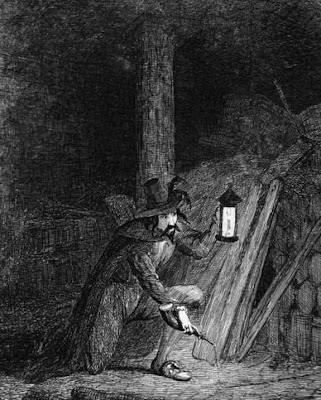 | Guy Fawkes, Or The Gunpowder Treason An Historical Romance By William Harrison Ainsworth. Published by G. Routledge, 1878, Original from Harvard University. Digitized Mar 25, 2008. 408 pages |
WITH ILLUSTRATIONS BY GEORGE CRUIKSHANK. LONDON. GEORGE ROUTLEDGE AND SONS, BROADWAY, LUDGATB HILL, NEW YORK: 416 BROOME STREET.
This image (or other media file) is in the public domain because its copyright has expired. This applies to the United States, where Works published prior to 1978 were copyright protected for a maximum of 75 years. See Circular 1 "COPYRIGHT BASICS" from the U.S. Copyright Office. Works published before 1923 are now in the public domain and also in countries that figure copyright from the date of death of the artist (post mortem auctoris), in this case George Cruikshank (September 27, 1792—February 1, 1878), and that most commonly run for a period of 50 to 70 years from that date.
Guy Fawkes (13 April 1570 – 31 January 1606) was a member of a group of English Roman Catholics who attempted to carry out the Gunpowder Plot, an attempt to blow up the Houses of Parliament and kill King James I of England, to destroy Protestant rule by killing the Protestant aristocracy, on 5 November 1605.
Fawkes was born on 13 April 1570 in Stonegate, York, the only son of Edward Fawkes (died 1579) and Edith Blake. His mother had given birth to a daughter, Anne, on 3 October 1568 who died seven weeks later on 14 November. Fawkes's mother bore two more daughters, Anne (born 12 October 1572) and Elizabeth (born 27 May 1575).
Guy Fawkes' father, Edward Fawkes, was a descendant of the Fawkes family in Farnley. He was either a notary or proctor of the ecclesiastical courts and later an advocate of the consistory court of the Archbishop of York. Edward's wife, Edith Blake, was descended from prominent merchants and aldermen of the city. Edward Fawkes died in 1579, and his widow remarried in 1582, to a Catholic, Denis Bainbridge of Scotton. The family were known to be recusants, resisters of the authority of the Church of England, and it is probable that his stepfather's influence contributed to Guy’s affiliation to Catholicism.
This article is licensed under the GNU Free Documentation License. It uses material from the Wikipedia article, Guy Fawkes
Technorati tags: Public Domain Clip Art and clip art or public domain and Guy Fawkes or Guy Fawkes Day or Voter Turnout in U.S. Elections Not Increased by Early Voting Measures and DC-3 Aircraft Que Sera Sera at the South Pole and Gold nanorods shed light on new approach to fighting cancer















No comments:
Post a Comment